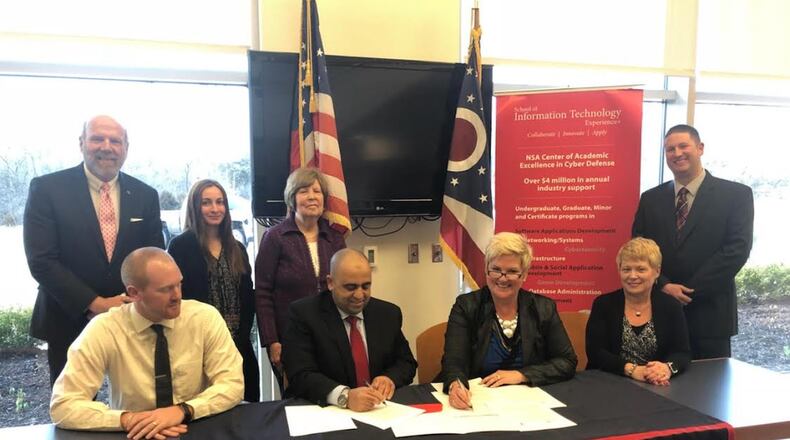That opportunity was handed to the district a year ago and it will come to life in the classroom this fall.
The district’s Director of Teaching and Learning, Joan Stidham, said she learned of the opportunity at a meeting of Southwest Ohio curriculum directors last spring when UC’s Director of the School of Information Technology Hazem Said introduced it. He told the regional curriculum leaders there is a shortage of qualified IT employees to fill all the jobs available in the area and they were proposing a program to fill that need.
Stidham said she came back excited about the prospect of taking part in the program and it was explained to district middle school and high school leadership teams.
“They were incredibly excited about getting to be part of this,” she said. “Then, it was how do we get the kids excited.”
That does not seem to be a big problem.
Said outlined a program in which teachers from each participating district would take classes to earn certification to teach college-level classes in the high schools. Students earning no worse that C-minus grades in the nine courses would then be guaranteed acceptance to the University of Cincinnati and be provided with a series of summer internships at which they would earn the money needed for the following year’s tuition.
Then, with training and experience for information technology jobs, they would be in the pipeline for jobs after college in that field, which is in need of qualified employees.
The UC program was put together with the assistance of a Cincinnati consortium of businesses which is concerned about the lack of a pool of qualified IT-trained people.
Zimmerman is one of nine high school teachers involved with the UC program and the first of the group to complete the 15 one-hour courses needed to teach the college-level course to be offered in the schools. He is now listed as an adjunct professor at the school and would be qualified to teach summer classes there when he is away from his Talawanda duties. He completed those classes in December.
He will begin by teaching an IT Fundamentals class at Talawanda this fall, which actually includes some of what he was already teaching, and that will be followed by a web design class. He will teach both of those classes but some of the subsequent classes students will take will be on-line in his classroom with him available to help students or clarify the material.
Students in the program will have access to the UC “Sandbox” all the university’s students use with programs needed to function in the on-line classroom.
“We will not need to buy programs,” Zimmerman said. “We will not let them twist in the wind. UC is opposed to letting kids take web-based classes by themselves.”
He said the program was created to expose potential IT employees to the local opportunities in hopes they would stay in this area and fill the job openings here, rather than moving to the east or west coasts or larger cities, which many see as the places to find information technology jobs. The Cincinnati Technology Consortium offers business leaders a chance to discuss ideas and work together on common concerns, such as the lack of trained IT professionals in the pipeline.
“They share ideas and be collaborative. They can’t find people to fill the jobs they have. UC is hoping to get more kids into UC and they will want to stay,” Zimmerman said. “We were looking for this next step, anyway, and this kind of fell into our lap.”
District STEM Instructional Leader Ryan Barter sees a double benefit to offering this program in addition to giving students interested in the IT field a step up and incentive to take part.
“It’s just as important for kids to learn they do not like a field before college. It’s a lot of work. Kids like playing games but many do not like designing them,” Barter said, referring to the class already offered in game design.
Zimmerman echoed that, saying students may find they do not like the work and can find a different educational path when they reach college. He pointed to the summer internships as a strong tool in the program giving the students not only the money to pay for the next college year’s tuition but valuable practical experience in the field.
“You could get through UC without paying a dime (in tuition),” he said. “Hazem said this is 60 Minutes material. I think you will see it in other fields if it succeeds. It’s a game-changer.”
Said and Talawanda Superintendent Kelly Spivey signed a contract March 26 formally adopting the program in the district as part of the College Credit Plus offerings giving student a college connection for their high school work.
Barter said many of the CCP offerings are generic but this one is defined and helpful to the students because it creates a specific pathway to a career for a larger segment of the school population.
Stidham said this will provide a strong opportunity for Talawanda students.
“This could get some kids on a path they were not able to do before. It has a goal of getting more IT kids in the pipeline because so many IT jobs are not being filled,” she said, adding the district is lucky to have Zimmerman in the position to work with the program. “We are really proud of him. He is a name at UC. The IT department knows him. That’s really cool.”
About the Author
